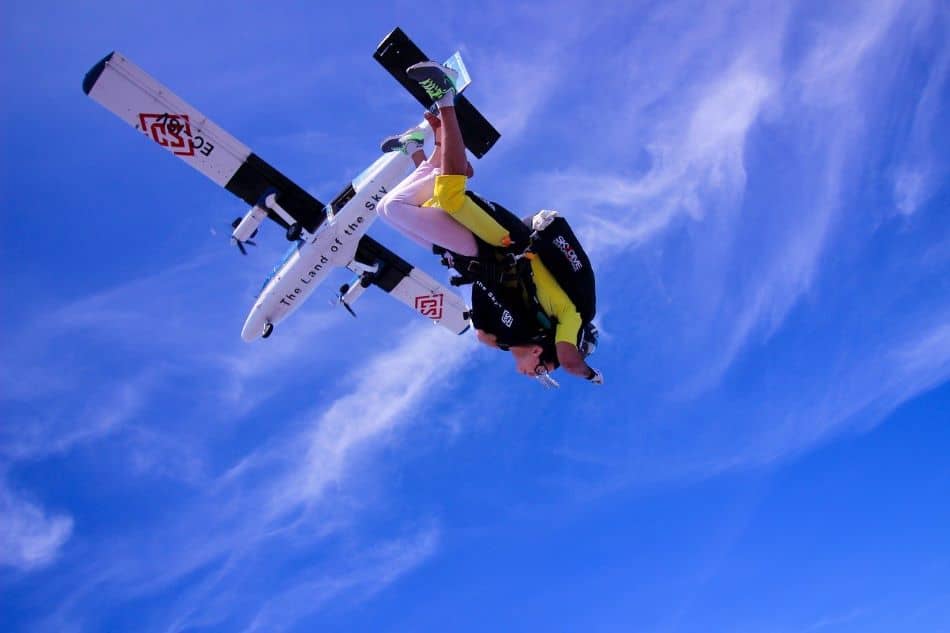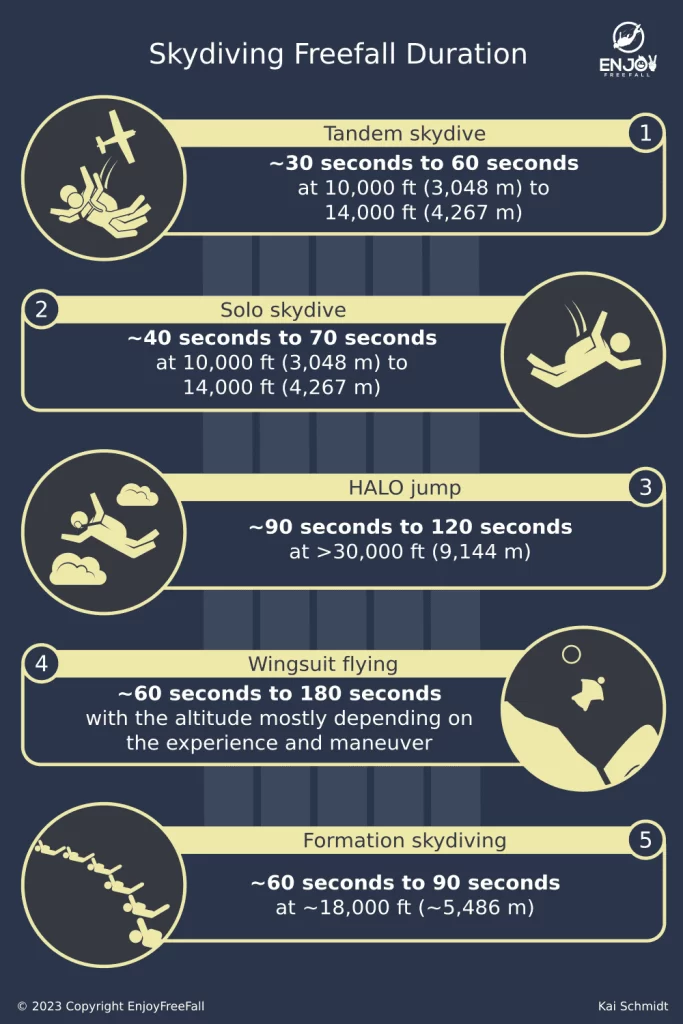
For first-time jumpers, skydiving can be scary. This is because they don’t know how it feels, and they rely on someone else to bring them down safely. People also often lose perspective for time when skydiving and wonder afterward, how long their freefall was.
If tandem skydivers exit at 10,000 ft they will be in freefall for 30 seconds. Jumping from 12,000 ft corresponds to 45 seconds of freefall and jumping from 14,000 ft gives around 60 seconds of freefall. Solo skydivers can achieve a longer freefall time because they can deploy their parachutes at a lower altitude.
The freefall time during skydiving depends on several factors including the jumping altitude, the parachute deployment height, the jumping weight, and the body position of the skydivers. In the following, I will explain the different factors and show ways to achieve a longer freefall time.
How Long Will You Freefall in a Tandem Skydive?
Tandem skydiving is popular with first-time jumpers. It will allow them to skydive while strapped to experienced tandem instructors, who will operate and control the skydiving equipment while the tandem jumpers are passengers.
The typical jump height for tandem skydivers is between 10,000 and 14,000 ft. This will allow the tandem pair to freefall at around 30-60 seconds, depending on their combined weight. This is enough time for the jumpers to look around and appreciate the beautiful scenery below, and pose to the camera if they opted to get a photo or video coverage.
If you’re wondering if there’s a weight limit in skydiving, delve into my dedicated article that unravels the mysteries behind the weight limit and explores its crucial role in skydiving. Discover the reasons why the weight limit should never be overlooked and gain a deeper understanding of its significance in your skydiving journey.
The freefall time for tandem skydivers is relatively fixed as the tandem instructors will usually deploy the parachute at 5,000 ft which means that you will be in freefall for 5,000 – 9,000 ft. If you want to increase your freefall time you can ask your instructor to go to a belly-to-earth position as soon as possible.
Skydivers have more air resistance in a belly-to-earth position and therefore achieve a lower speed. Tandem skydivers have a speed of around 120 mph in the belly-to-earth position which is much lower than the 185 mph that they have in the head-down position.
This difference in speed can give you a much longer freefall time. For example, if you jump from 14,000 ft in a belly-to-earth position you will have a freefall time of 55 seconds whereas you will only have a freefall time of 40 seconds if you jump in a head-down position. You can find an overview of the differences below:
| Jumping Altitudes (in ft and meters) | Freefall Time in a Belly-To-Earth Position (in s) | Freefall Time in a Head-Down or Feet-Down Position |
| 10,000 ft (3,048 m) | 32 s | 25 s |
| 11,000 ft (3,353 m) | 38 s | 29 s |
| 12,000 ft (3,658 m) | 43 s | 32 s |
| 13,000 ft (3,962 m) | 49 s | 36 s |
| 14,000 ft (4,267 m) | 55 s | 40 s |
Please note that your weight will also slightly impact the calculations – so you might have 1-2 seconds more or less freefall time. The numbers in the table also refer to “pure” positions whereas the time given in the prompt refers to “mixed” positions.
Realistically, you will be in the head-down position when exiting the airplane and the belly-to-earth position when deploying the parachute. The table figures are calculated with the assumption that you hold the position during the complete freefall.
It is often hard for first-time skydivers to tell how long they had been in freefall during their first skydive because they lose their sense of time. This is quite common because you will experience a sensory overload during your first skydive.
If you want to learn more about the 7 true feelings of skydiving, check out this article.
How Long Is the Freefall for Solo Skydivers
In general, solo skydivers usually experience a longer freefall than tandem skydivers. This is caused by a lower deployment height. While tandem instructors deploy the parachute at around 5,000 ft, solo skydivers often deploy at only 2,500 ft (or even lower). As a result, they fall 2,500 ft more which results in a longer freefall.
This effect is weakened because solo skydivers often do not achieve the same speed as tandem skydivers because they are much lighter. They will have a speed between 100 – 120 mph in the belly-to-earth position and 150 – 180 mph in the head-down position.
| Jumping Altitudes (in ft and meters) | Freefall Time in a Belly-To-Earth Position (in s) | Freefall Time in a Head-Down or Feet-Down Position |
| 10,000 ft (3,048 m) | 46 s | 37 s |
| 11,000 ft (3,353 m) | 52 s | 41 s |
| 12,000 ft (3,658 m) | 57 s | 45 s |
| 13,000 ft (3,962 m) | 63 s | 49 s |
| 14,000 ft (4,267 m) | 69 s | 53 s |
Again, this table is calculated based on the assumption that a person holds the same position from the exit of the aircraft until the deployment of the parachute. For a 14,000 ft jump, it might mean that the “real” freefall time is more around 60 seconds because you will perform parts of the jump in a head-down position.
Freefall Time During HALO Jumps
If a skydiver wants to experience a significantly longer freefall, he can skydive from significantly higher altitudes and perform a “High Altitude Low Opening” (HALO) jump. A HALO jump describes a jump from above 30,000 ft.
They require special equipment for breathing and navigating and skydivers need to have at least the ‘B’ license. A HALO jump will give a freefall between 90-120 seconds depending on the weight, body position, and also weather (but only slightly).
Freefall Time With a Wingsuit
Wingsuit flying is a special skydiving discipline that involves a wingsuit, also called a “squirrel suit” or “birdman suit”. Wingsuits add more surface and enable the skydiver to have higher air resistance. It thereby increases the lift and decreases the falling speed, which in turn will result in longer freefall. The skydivers will be able to glide longer and travel horizontally.
Besides the exit altitude, the “freefall” time during wingsuit flying depends a lot on the experience of the skydiver and how he flies the wingsuit. It typically ranges from 60 to 180 seconds.
As a result, wingsuit flying can also be done by jumping from lower objects such as tall cliffs or mountain tops. It also contributed to the development of BASE jumping. Some people argue that flying a wingsuit does not feel like freefall anymore. In my experience it feels very similar – so I count it as freefall.
On 20 and 21 April 2012, Colombian skydiver Jhonathan Florez was able to set two Guinness World Records for the highest altitude wingsuit jump at a height of 37,265 ft (11,358 m) from an aircraft. It was also the longest recorded wingsuit flight with 9 minutes and 6 seconds before deploying the parachute.
If you’d like to see more record-winning jumps, I wrote an article that showcases the longest wingsuit flight duration where I also explained how long a wingsuit flight lasts. Check it out here. You willb be stunned by how wingsuit pilots have pushed the boundaries of skydiving.
The main difference between wingsuit skydivers and the typical skydiving is that the former will need to unzip their arm wings after the deployment of the parachute to reach the steering toggles and control the parachute to safely land to the ground. Also, to be able to qualify as a wingsuit skydiver, they will need to be a skydiving “C” license holder and complete a wingsuit course.
Wingsuit is a subdiscipline of skydiving that requires a different set of skills and gear. If you’d like to know more about the difference between skydiving and wingsuit flying, read my article about the 11 stunning differences between skydiving and wingsuit flying.
How Long Will You Freefall in a Formation Skydive?
Formation skydiving is a discipline that involves a group of skydivers ranging from 2 to 6 people. They will fly in a belly-to-earth position, which will allow them to freefall for about 60-90 seconds. The goal of formation skydiving is to move relative to each other to take grips and make shapes.
These skydivers normally jump from higher than 18,000 ft to increase their freefall time and be able to complete their formation routine.
On 31 July 2015, 164 skydivers from different training camps in Spain, Australia, and across the US broke the record for vertical formation jump, beating the 2012 mark that was set by 138 skydivers.
Seven aircraft were flown in precise formation and carried the 164 skydivers together with the videographers. They exited between 18,000 and 19,000 ft at a speed of up to 175 mph, which gave them between 60-80 seconds of freefall.
To make it even more interesting, instead of the typical belly-to-earth position, they decided to do a head-down fly. Each skydiver had an audible altimeter in their helmet which, in this case, was set for different break-off altitudes.
After successfully holding the giant flower-shaped formation for a few seconds, the first wave broke at 7,500 ft while the other skydivers followed in three other waves at lower altitudes.

Three Ways for Skydivers to Manipulate Their Freefall Time
Skydivers can either increase or decrease the freefall time according to what they like best. Here are three ways how skydivers manipulate their freefall time.
The Type of Jump Can Increase Your Freefall Time
Tandem skydiving consists of two individuals (tandem instructor and student jumper) which will make the combined weight greater compared to solo skydivers. As a result, the tandem pair will experience a freefall of between 40 and 60 seconds from jumping out of an airplane at the height of 10,000 to 14,000 ft.
In comparison, solo skydivers have a longer freefall time since their weight is lighter. The traditional belly-to-earth position will allow them to freefall between 50-65 seconds at an altitude of 10,000 to 15,000 ft.
In addition, performing a wingsuit jump will also increase the time in the air, or perform a base jump to decrease the time in the air. Certain formation jumps and stunts will also increase or decrease the falling speed and thereby the freefall time.
The Jump Altitude And Deployment Height Impact Your Freefall Time
To experience a longer freefall, skydivers can increase their jump height to more than 15,000 ft. This, however, will require them to wear oxygen support since the oxygen concentration gets thinner as the altitude increases.
Experienced and adrenaline-junkie skydivers also perform high altitude jumps that are above 30,000 ft. These heights will enable them to experience more than two minutes of freefall and bring their skydiving experience to the next level.
If skydivers do not want to jump from higher altitudes, they can decrease the deployment height for their parachute. However, the deployment height depends on the license and skill level of the skydiver. A lower deployment height means that the skydiver has less time resolving any potential parachute malfunction – he, therefore, should be experienced enough to quickly react.
Speaking of skydiving license, if you stumbled across this article without having one for yourself, be sure to check out my article about how to get a skydiving certificate. It covers the whole licensing process and reveals easy and practical tips to excel at the license!
If (for any reason) skydivers want to decrease their freefall time they can perform hop and pop jumps. They will exit an airplane at a height of 5,000 to 6,000 ft and immediately deploy their parachute and prepare for landing. This will significantly decrease the freefall time to 2-3 seconds, which is just enough time for the skydivers to have clearance from the aircraft to avoid any collisions.
The Body Position Can Increase Your Freefall Time
As mentioned before, solo skydivers can play around with their body position to be able to increase their freefall time. They can simply change to a horizontal body position to slow down.
Skydivers on a vertical body position can experience a faster fall — between 33 and 45 seconds—compared to a belly-to-earth position which gives about 50-65 seconds of fall at the same jump height of 10,000 to 14,000 ft. They can also move their body on the side to increase the speed and decrease the time spent on a fall.
What Does Freefall Feel Like?
Free Falling is the closest that someone can get to flying. Once skydivers reach the terminal velocity (i.e. the state of zero acceleration), they will feel like floating in the air. It’s a liberating feeling that skydivers look forward to every jump.
One thing that first-time skydivers often forget is to deeply breathe during the freefall. If you breathe properly, your perceived time will slow down because you do not panic.
It is often easier said than done because one is full of adrenaline during the first jump and winds at a speed of 120 mph blows in one’s face but breathing can be key to a good skydiving experience.
If you want to learn more about how skydivers breathe and get some tips on how you can ensure proper breathing, you can read this post.
That being said, enjoy your freefall!




